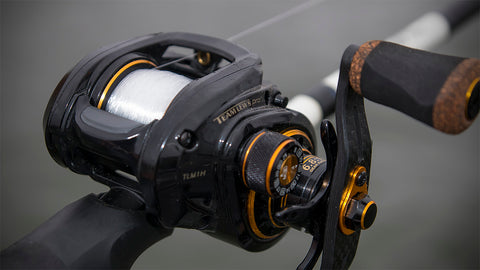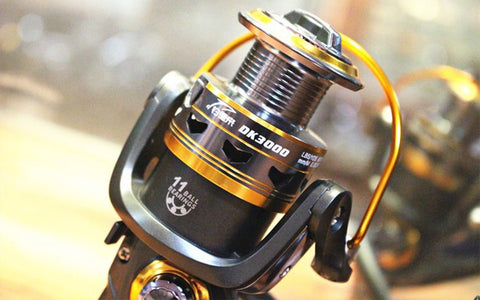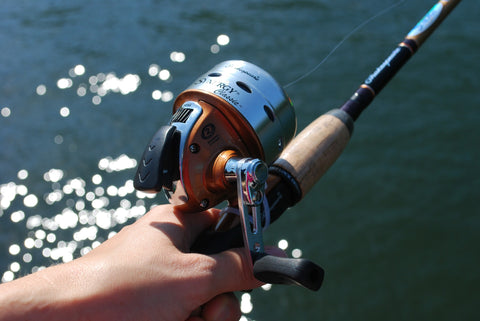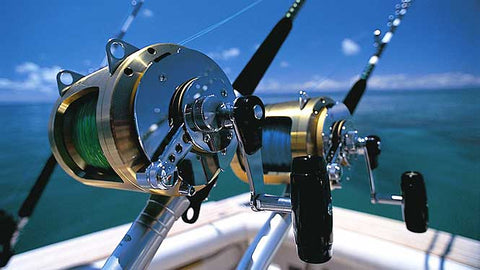Saltwater fishing reels are usually larger and are needed to land larger fish. These reels are perfect for fishing the oceans and inhore gulf coast waters. There can be many different types of saltwater reels that include: Bottom fishing reels, trolling reels and jigging reels. As for freshwater fishing reels they are usually lighter and better suited for a long day of casting to find fish. These reels are used in lakes by bass fishermen, stream and rivers.
No matter the reel manufacture or the marketing stratagy there are only 3 different types of reels. The three basic styles of fishing reels include casting reels, spinning reels and fly fishing reels. In order to purchase exctly what you need, a basic knowledge of how the fishing reel works is needed.
Baitcasting Reels:

Baitcasting reels are often called baitcasters. Baitcasters have been known to be the reel of choice for experienced anglers. They are more difficult to learn on and has a larger learning curve before they can be mastered. The difficult issues with these reels are with back-spools or birdnests when casting. Baitcasting reels have a drag system which is sensitive to the drag or resistance generated from your reel spool. This is critical because when casting it controls the resistance needed to let the right amount of line off the reel. Its because of this that most anglers use baitcaster reels for large game fish. These reels have taken over the bass fishing world and are often prefered by offshore fishing saltwater anglers.
Spinning Reels:

Spinning reels are usually the reel of choice for beginner anglers. These are the simplest and easiest to use on a spinning rod. Spinning reels are easy to cast because the spool is parallel on the rod and does not rotate as you cast. It is impossible to cause back-lash and birdsnest on these rods. Most spinning reels come equiped with anti-reverse mechanism that prevent line from being spooled during a bite. Usually spinning reel are pefect for light line and various live bait set ups. Often times you do not want to hurt live bait when casting, so angler chose this reel to get the job done because of its simplicity of operation.
Spincasting Reels:

A simple reel that has a thumb button to cast. The spincast reels works like a spinning reel with a cover. The spool is enclosed by a cover with an opening that the line exits. When casting, press the thumb button and release. When you release the button your line and lure is propelled with the force from the cast. Often time these types of reels are perfect for teaching a young child how to fish. There is very little you can do to mess it and not be able to cast.
Saltwater Reels:

These reels are often either a spinning reel or a baitcasting reel. These reels are usually more heavy duty than your freshwater fishing reels. When it comes to saltwater reels, spinning reels are better than baitcast reels when required to cast long distances. Pier and surf fishing come to mind and often require a large spinning reel. If you are offshore fishing or fishing for large fish in general, then a baitcaster reel is prefered due to the man handling ability to pull a fish off the bottom or prevent one from going into structure. The better saltwater reels have extensive gear ratios in order to help aid in catching big fish.
If you want a reel to be able to catch large tarpon to big jewfish then the reel we would refer to you would be the Canyon Reels HS-18. This reel will handle some of the largest fish with ease.
Drag Systems:
If you are an amature fisherman, then im sure you have heard the term "tighten your drag". What exactly is drag? The drag on a fishing reel refers to the amount of friction that is applied to the spool.
Why do you need this?
The drag is what aids in casting to allow you to get distance on your bait. It also allows for you to be able to set the rod down and not fear of losing it because you have loosened the drag which allows for the fish to take line more freely. Once a fish is hooked, the drag should be adjusted slightly to allow the friction of pulling line to wear the fish out. Traditionally all reels come with fixed drag. The breakoff ratio was a lot higher then, so reel manufactures crafted ways to dial down the amount of drag needed.
When talking about drag, all anglers must know that there are three types of drag: sping and pawl, disc drag and caliper drag. Spring and pawl drag is a drag system that has a distinct clicking sound when line is being pulled off the reel. Found often on saltwater reels, this drag system has a spring that pushes the prawl into a gear on the reel spool. The disc drag system is probably the smoothest of the three. Found often on fly fishing reels, the disc drag pushes a large pad against the reels spools breaking surface. The disc drag is often adjustable allowing experinced angler to fine tune the level of drag pressure needed to land a fish. The last type of drag is the caliper drag system. This is a cross between a disc and spring and prawl.
With so many options in when shopping for fishing reels, it is important to remember to get exactly what you need as a affordable price. No matter what style and size you choose, always make sure it's appropriate for your intended target fish.
If you have any questions about fishing reels please leave a comment below or email us at [email protected]. Shop our great selection of fishing reels at elliottenvisions.




Comments
Leave a comment